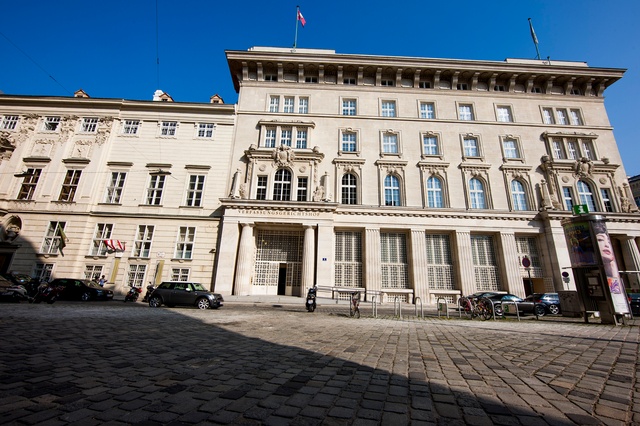Building
Since August 2012, the Constitutional Court has resided in the building complex at Renngasse 2 / Freyung 8 / Tiefer Graben 1–5. The official address of the Court is Freyung 8. Its entrance is at the corner of Renngasse.
The building, which also hosts the “Bank Austria Kunstforum”, was designed by the well-known architects Ernst Gotthilf and Alexander Neumann and erected between 1914 and 1921 for a bank called “Österreichische Creditanstalt für Handel und Gewerbe” (“Austrian Credit Institute for Trade and Commerce”). The impressive building features elements of neo-classicism and imitates a Renaissance palazzo. The entrance is modelled on a Roman portico. In its entry on the bank buildings designed by the two architects - Gotthild and Neumann also designed building for other banks, such as the Wiener Bankverein, Schottengasse 6–8; and the N.Ö. Eskompte Gesellschaft, Am Hof 4 – the “Architektenlexikon Wien 1770–1945” (Viennese Encyclopedia of Architecture) notes:
“The architects incorporated design features typical of historicism. With their choice of style, they open up a whole range of associations for the user. By taking inspiration from the forms of antiquity for a bank building, they invoke notions of consistency and security, while signalling an honourable attitude. At the same time, modern forms represent the dynamics of commercial life and stand for progressive financial management.” (Ernst Gotthilf, in: Architektenlexikon Wien 1770–1945)
The building covers the space previously occupied by five older building plots. On one of them, at the corner of Renngasse / Freyung, there was a house called “Zum Goldenen Straußen” (“The Golden Ostrich”); the house at the corner of Freyung / Tiefer Graben was called “Zum rothen Mandl” (“The Red Man”). As the system of numbering buildings was only introduced in 1770/1772, signs and house names were used until then. Around 1700, “Zum Goldenen Straußen” was an inn frequented mainly by travelling shoemakers – “Schuhknechte” as they were called at the time.
Between 1760 and 1764, the inn had to make way for a five-story apartment block. In 1856, the “Niederösterreichische Eskomptegesellschaft”, founded in 1853, bought the building and subsequently joined it to the building next door at Freyung 9, bought in 1871. In 1914, this building complex was taken over by the “Österreichische Creditanstalt für Handel und Gewerbe”, demolished and replaced by the present building. After the collapse of the “Österreichische Creditanstalt für Handel und Gewerbe”, the building changed owners several times. In 1968 it was bought by the “Österreichische Länderbank”, which became “Bank Austria” in 1990. The current owner is “Renngasse 2 Immobilien GmbH & Co KG” (a real estate company), which was acquired by “JR Real Invest GmbH” in February 2025.
On entering the building that houses the Constitutional Court, an elegant staircase leads up to the first floor, where the rooms have been preserved in their original state and are now listed as a historical monument. The offices of the president and the vice-president, as well as the main courtroom, in which the Constitutional Court holds is public hearings, are located on this floor. A meeting room for the members of the Constitutional Court is also accommodated there. In the foyer of the courtroom, the president’s press briefings are held at regular intervals.
The judges, the clerks of the Court and the administrative staff have their offices on the upper floors. The consulting room for the members of the Constitutional Court, the library and an event centre equipped for conferences and public functions are located on the fifth floor.
Since autumn 2020, the building of the Constitutional Court has been flagged not only with the flags of the European Union and the Republic of Austria, but also with the flag of the federal state (Land) that presides over the Federal Council. This is intended to symbolically express the specific position of the Constitutional Court as a joint organ of the Federation and the federal states (Länder) ("bracket that unites the dualistic construction of the Federation and the Länder into a higher unity": AB 991 BlgKNV) at the seat of the Court.






























